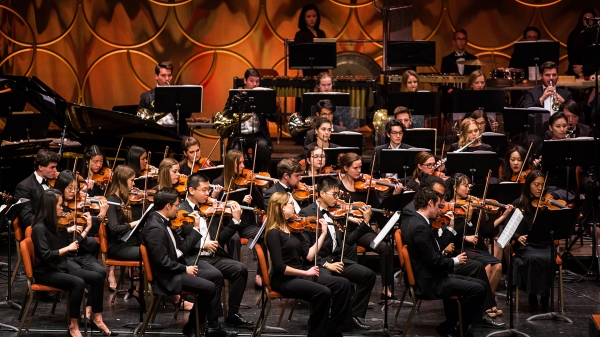Powerful new opera 'Guadalupe' blends cultural perspectives

Photo by Sean Hoyer
The School of Music strives to perform new works on a regular basis as part of its Lyric Opera Theatre season lineup, but it doesn’t often have the chance to present a brand-new show also written by a member of its own faculty.
This November, however, the school is fortunate to showcase the world premiere of “Guadalupe,” a multilingual opera in two acts composed by ASU’s own professor of composition and music theory, James DeMars.
"On behalf of the Lyric Opera Theatre, it is with great anticipation and excitement that we present this performance of ‘Guadalupe,’” says Brian DeMaris, director of the Lyric Opera Theatre. “We are preparing our students for careers in which most of their engagements will be with new works, and it is and will continue to be an integral part of our training. Providing students with opportunities to engage with living authors is an essential part of what we do.”
“Guadalupe” centers on the story of how the Virgin Mary appeared to peasant Juan Diego (Cuauhtlatohuac), near the Aztec Temple of Mother Earth (Tonantzin) near Mexico City between Dec. 9 and 12, 1531. According to Diego’s testimony, Mary was robed in a striking blue color, with rays of light radiating around her. This image of Mary, known as the Virgen de Guadalupe, is central to the traditions of the Mexican Catholic religion and is easily recognizable in art works as an important symbol of that faith. December 12 has since become a popular Catholic holiday to remember this story and celebrate Mexico’s patron saint, who promoted a message of hope and peace.
Other central themes of the opera include the first peace treaty of the Americas, and the revelation of the miraculous, blended portrait of the Aztec and Spanish Mother Mary that inspired peace throughout the Americas.
In May 2008, at St. Mark’s Episcopal Church in Mesa, two debut concerts of the “Guadalupe” musical score were performed as an opera-oratorio – without the costumes and sets that define a traditional opera. The performance was recorded and released by Canyon Records as a co-production with the School of Music. Reviews were glowing: “As the last notes faded I sat awestruck ... this opera was a milestone in the history of contemporary music,” wrote Ruben Hernandez for Latino Perspectives Magazine.
Known for works that explore intercultural collaborations, DeMars says, “Composing this opera provided me a remarkable opportunity to bring together the two sides of my career: the classical works, which include cantatas, concerti and a requiem, and the intercultural works, which feature Native American, Hispanic and African artists performing with traditional classical ensembles.” In 2010, he was honored with the Arizona Governor’s Arts Award for his efforts on this opera.
The November premiere of “Guadalupe” – the first time it will be performed as a full-length opera – also aligns itself with ASU’s mission of commitment to community engagement and connection to place, since it reflects stories and history that are integral to the identity of the borderlands of Arizona and Mexico. This world premiere will be the sixth co-production by the ASU School of Music and Canyon Records, which has been specializing in Native American music since 1951.
Following the final performance on Sunday, Nov. 22, at the Evelyn Smith Music Theater on ASU's Tempe campus, audience members will have the opportunity to participate in a talk-back session with the creators and cast members.
“Composing this opera provided me with a chance to bring together musicians from many cultures for this series of performances, including Native American flutist R. Carlos Nakai (Navajo-Ute), and Mexican percussionist/flutist Xavier Quijas Yxayotl (Huichol), as well as the African percussion resources of my long-time colleague Mark Sunkett,” DeMars says.
The opera’s plot revolves around Juan Diego’s efforts to have his vision accepted as a miracle by the Roman Catholic Church, but the deeper, underlying theme is the ever-relevant concept of reconciliation between warring cultures and achieving peace through non-violence.
In voices that blend English, Spanish and Aztec languages, the opera’s powerful notes and dramatic storyline don’t just weave together a fictional story, they address timeless issues that apply to today’s inter-cultural challenges, much as how they did when Juan Diego first saw the visions in 1531.
“The finale of the opera is my favorite part,” DeMars says. “Performers sing about coping with U.S.-Mexico immigration issues and the cultural differences that separate the two nations."
The themes of reconciliation and acceptance recur throughout the opera’s centuries-old storyline, yet audiences will come away feeling equally as awe-inspired and hopeful about the modern-day issues of our borderlands. “I open the opera with a euphoric epiphany, revealing the experience of hope, and close with a final prayer for peace,” says DeMars.
Showtimes: 7:30 p.m. Nov. 19-21 and 2 p.m. Nov. 22 at the Evelyn Smith Music Theater on ASU's Tempe campus
Music composed by James DeMars
Libretto by James DeMars, Robert Esteva Doyle and Graham Whitehead
Sung in English and Spanish with English supertitles
Stage Director: Graham Whitehead
Music Director: William Reber
Choreographer: Lauren Margison
Production Designs: Alfredo Escarcega
Costumes, hair and makeup: Sharon Jones
Lighting Design: Jeff Jann
This opera contains mature themes and may not be appropriate for young children.
Ticket prices: $21 for adults; $15 for faculty, staff and alumni; $12 for senior citizens; $10 for group purchases (minimum of 10 tickets); $8 for students.
A $2 handling fee applies to all orders, and a web per ticket purchase fee will apply.
To order tickets, call the Herberger Institute Box Office at 480.965.6447 or visit music.asu.edu/events. Box office hours are 11:30 a.m.–5:30 p.m. Wednesdays through Fridays, 2-4 p.m. Saturdays
Heather Beaman School of Music Communications Liaison 480.727.6222 Heather.M.Beaman@asu.edu
More Arts, humanities and education

Small presses dealt big blow
A mighty rumble reverberated throughout the publishing industry late last month with the abrupt closure of a well-known book…

'Living dress' wins Eco-Chic sustainable fashion contest
When Elena Marshall is done showing off her award-winning “living dress,” she’ll bury it in her backyard. The dress, a chic…

ASU Symphony Orchestra welcomes visionary conductor Jonathan Taylor Rush
Guest conductor Jonathan Taylor Rush will join Arizona State University’s Jason Caslor, director of bands, to lead the ASU…